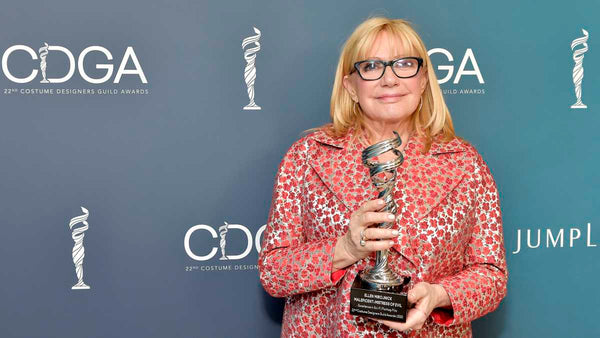
Ellen Mirojnick is an American costume designer from New York whose work you will know from many Michael Douglas movies including Fatal Attraction (1987), Wall Street (1987), Basic Instinct (1992), A Perfect Murder (1998), Wall Street: Money Never Sleeps (2010) and Behind the Candelabra (2013). The costumes she created for Douglas’ Wall Street character Gordon Gekko inspired a fashion trend in the late 80s and early 90s for boldly patterned ties and colourful suspenders in men’s business wear. It was one of the most influential suiting movies ever made.
As such, she knows her way around menswear and was the perfect candidate for Christopher Nolan’s 2023 epic biopic Oppenheimer. Mirojnick had previously worked with one of the film’s stars, Robert Downey Jr., on another biopic, Chaplin (1992), for which he was Oscar nominated for his performance.
She won an Emmy and CDG award for her work on Behind the Candelabra and was given the Career Achievement award by the CDG in 2016. She was again nominated in 2017 for The Greatest Showman. She received her first Oscar nomination for Oppenheimer at this years’ Academy Awards. She also received a BAFTA nomination for her work on the film.
Showcasing her range, she has also designed within the Sci-Fi/Fantasy genre with Starship Troopers (1995) and Maleficent: Mistress of Evil (2019) and for television with the Netflix period drama Bridgerton (2020-). She currently has 76 design credits on IMDb.

As Cillian Murphy has been referencing in his Oppenheimer press interviews, early on in the process Chris Nolan sent him an image of David Bowie during his Thin White Duke era as inspiration for the look of the titular character.

Even though the film takes place in between the 1930s and 60s, Nolan wanted the costumes to be timeless. Mirojnick told The Hollywood Reporter that “[Bowie’s look] is very similar to Oppie’s silhouette,’ unbeknownst to the ’70s, to the ’30s and ’40s. And that being a keynote, we were able to create a silhouette on Cillian’s sculptural body and, taking into consideration [the] frailty, to make it larger. It’s two iconoclasts meeting at different periods of time. There are plenty of men and women that wanted that same silhouette: the voluminous trouser, the wide shoulder.” And with that, she was able to create a look that spanned the decades.

The silhouette of an emaciated Murphy with Oppenheimer’s distinctive silhouette complete with wide brim hat has become the emblematic image of the film and if the internet is to be believed, ushered in a renewed interest in high-waist voluminous pleated trousers for men. He was the only non-military character to wear a hat in the film other than Albert Einstein. He was the sheriff of Los Alamos in that hat. Oppenheimer’s style and silhouette did not change throughout the different time periods the film takes place in. His suits and hat were his uniform throughout his life. Murphy wore just ten suits and two hats in the whole film.

Of Oppie’s colour palette, Mirojnick told WhoWhatWear that she “chose only to [have him] wear blue shirts and tones of blue and gray in the suiting in urban environments. When he gets to New Mexico, he wears two entirely different colors with more of a work fabric and whipcord suiting that is very sympathetic to the land. The only time he wears the lighter of the two colors [in New Mexico] is when he's in the desert for the Trinity test. I think that one bleeds into the other, and it's somewhat like painting a portrait of this man and creating his character.”

The costuming of this film, which consisted primarily of men’s suiting, came down to very specific detailing for each character and their scene. What type of collar, if there is a pin in the collar, the type of tie, the pattern, the colour, the fabric, cuff links etc. were all meticulously planned out in order for everyone to look individual yet unified together.
On designing for all of the different scientists in the film, she said that “each one took on a different tonality, a different silhouette. I love designing menswear because menswear is not embellished. It is very expressive and informative. It is in a cut of a jacket, the drape of a trouser, the proportions of all of the elements combined, and it really does make the character and it makes the man, by virtue of putting all of those pieces together.” THR

All of the principal characters’ clothing was built while the rest was sourced from costume houses and vintage sellers. Craftspeople were working in Ireland, across the USA, Hungary and Canada to make all the required pieces for the film. They ended up with 1,000 costumes in total.

There’s no doubt that it’s the biggest menswear movie in years! Best of luck to Ellen on March 10th!
Here are two looks from our rentals collection inspired by Oppy:


